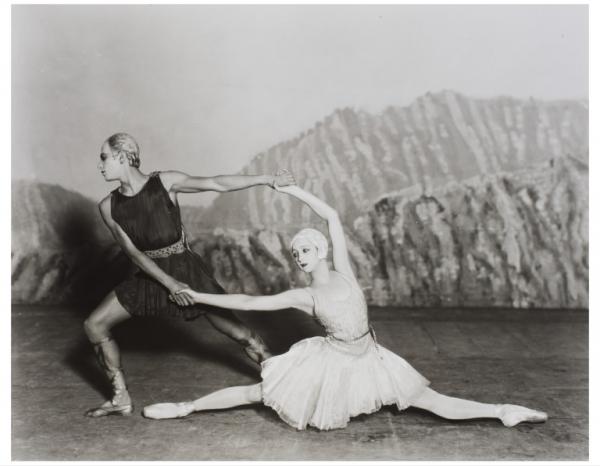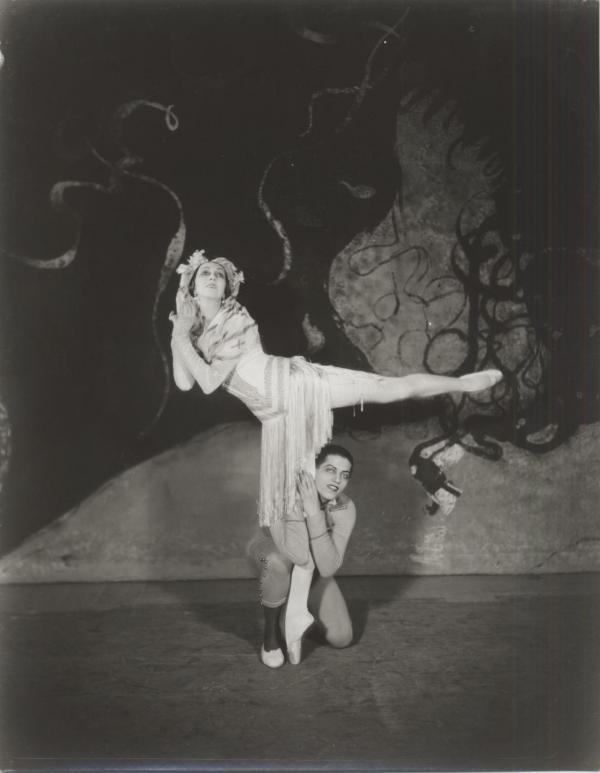
Serge Lifar and Alexandra Danilova as Apollo and Terpsichore in Apollon musagète, 1928. Photo Sacha, V&A images
One of the on-going complaints about the exhibition (well there have to be some!) is the lack or absence of material on Apollon musagète which, I will happily acknowledge, was one of the greatest creations of Diaghilev’s Ballets Russes. Also there are complaints about the minimal amount on Apollo’s choreographer George Balanchine.
I do not agree that Balanchine is treated any less favourably than his choreographic colleagues except in that we do not show any of his choreography on our screens. The exhibition includes material on Le Chant du Rossignol, La Pastorale, Jack in the Box, The Triumph of Neptune, La Chatte, Le Bal and The Prodigal Son as well as Apollon musagète.
The Apollo material is in our section on ‘Inspiration’. There, at the start of the second gallery, you will find André Bauchant’s oil painting that provided the basis of the setting – it can hardly be called a set design in the traditional sense – on loan from the Wadsworth Atheneum. The rocky ridge became the set, and the flat-footed characters are reflected in Balanchine’s choreography. Apollo’s chariot, which featured at the end of the production, also inspired motifs in the dance. The painting is displayed next to the screen on which we project our collage of images, source material for numerous productions. Among them are a costume design by Jean-Baptiste Martin for Apollo for the Opéra de Phaëton from the Galeries des modes et costumes Français (1779). This is included both as a traditional image of the sun-god holding his lyre and because this costume was reworked by Léon Bakst as his design for Princess Aurora’s wedding dress for her entry into the final scene of The Sleeping Princess.

Bakst’s design for Princess Aurora’s wedding dress 1921
We also include to images that influence movement material in the ballet: a night scene of Piccadilly as the flashing neon lights were said to have inspired the opening and closing of the hands in Apollo’s solo, and God reaching out to Adam (as represented in Michelangelo’s Sistine Chapel painting) a motif Balanchine reused but that most famously influences the opening gesture of the pas de deux for Tepsichore and Apollo.
We did consider including the painting copied for the ballet’s original front cloth (also owned by the Wadsworth Atheneum) but it is considerably larger than the ‘set’ painting and they look uncomfortable displayed together. Remember we had to cut down out original selection of material by a half! We also cut a drawing of Serge Lifar as Apollo by Eileen Mayo. but that will be included at tour venues (which will have a rather different exhibition). It must be said that although there are wonderful photographs of Apollon musagète particularly by Sasha in London in 1928 (first version of the muses costumes) there is not a lot of material surviving from the performances by the Ballets Russes in 1928 and 1929. I always think that one of the costumes I would love to have had to display would have been Lifar’s red and gold tunic, belt and cloak for Apollo and I have always been intruiged as to what became of lot 218 in the 1973 Chenil Galleries sale described as Tchernicheva’s 1928 costume as Calliope ‘lilac pleated chiffon bodice, full skirt of silver organza. Skullcap sewn with lilac and purple flowers’ a description which always I think mucks up the constant reference to Apollon musagète as a ‘ballet blanc’.
Finally on Apollon musagète we also include a telegram from Edinburgh to Diaghilev in Paris concerning the casting of the ballet ‘TELEGRAPHIEZ QUE DANSE APOLLON PLACE TCHERNICHEVA’?
In selecting material for any exhibition one is trying to balance the familiar with the less known. I was rather pleased to be able to include Balanchine’s La Pastorale. It may not have been a great ballet but like La Chatte it was one in which he was clearly experimenting with movements he was going to continue to develop to enhance the ballet vocabulary.

La Pastorale 1926 with Serge Lifar as the telegram boy clasping the leg of the Film Star (Felia Doubrovska. It may not look wonderfully elegant but it is a reminder of unusual supported turns we now associate with Serenade. Photo Sasha V&A Images